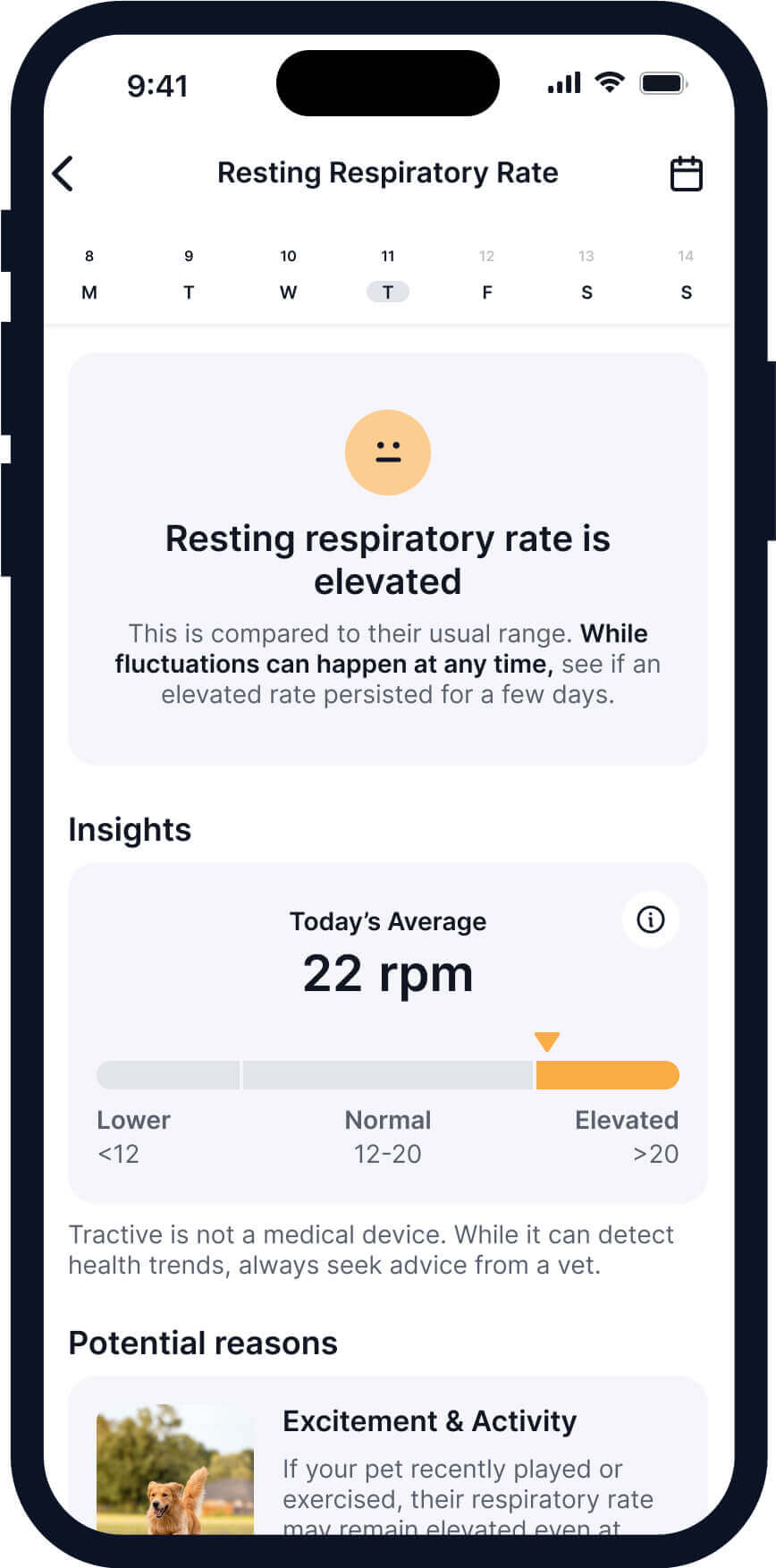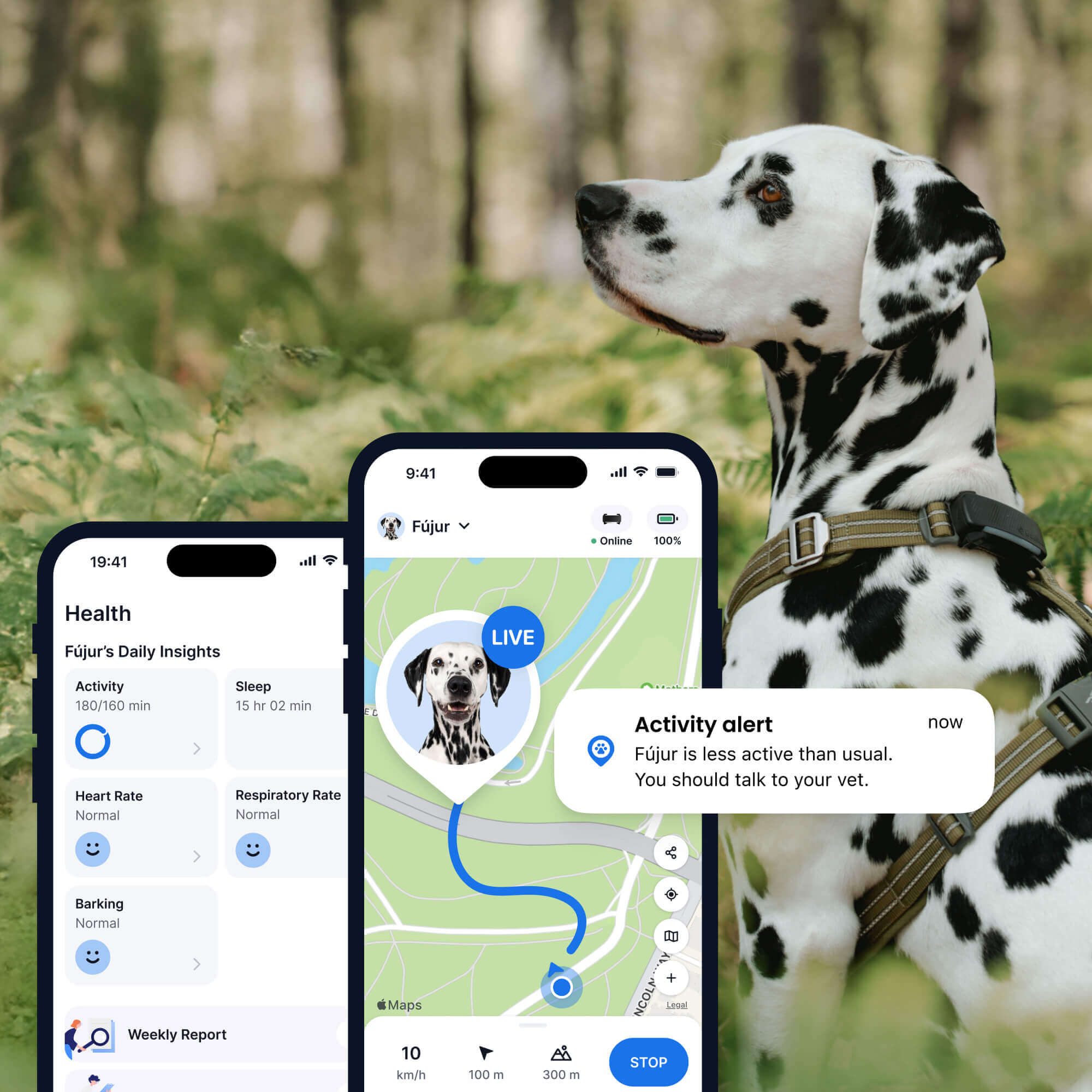 Approved by Dr. Dwight Alleyne, DVM
Approved by Dr. Dwight Alleyne, DVM How To Handle Syncope in Dogs (Or Dog Fainting)
While it might look like a seizure at first, syncope in dogs has its own causes, signs, and treatments. Here's how to spot it & what to do.

Have you ever seen your dog suddenly collapse, just for a moment, then pop back up like nothing happened? It can, understandably, be pretty scary to witness. This temporary loss of consciousness is called syncope – or, simply put, fainting. Let’s break down the signs of syncope in dogs, how it’s treated, and how a smart dog tracker with Health Monitoring can help you catch on to it early.
Key Takeaways
🧠 Syncope (or fainting) in dogs is a temporary loss of consciousness due to reduced blood flow to the brain.
🫀 Common causes include heart disease, low blood pressure, coughing, overexertion, and metabolic or neurological issues.
👩⚕️ Your vet will use a combination of medical history, physical exams, and diagnostic tools to identify the cause and recommend treatment.
🌎 Tools like the Tractive GPS & Health Tracker can provide early Health Alerts and data to help you and your vet catch health issues sooner.

Always know your buddy is healthy & safe
Read moreWhat is syncope in dogs?
Syncope is a medical term for what we commonly call “fainting.” In dogs, it’s a sudden, temporary loss of consciousness that happens when there’s a brief interruption in the brain’s blood supply. This drop in blood flow can be caused by a variety of issues, most often related to the heart or circulation.
When a dog experiences syncope, they might collapse without warning, appear limp or unresponsive for a few seconds, and then recover quickly like nothing happened. It’s easy to confuse with a seizure, but the causes and symptoms are quite different (more on that below).
⚠️ Syncope doesn’t hurt your dog in the moment, but it’s a major red flag that something more serious could be going on inside their body. Because it can be a sign of heart disease or other underlying health issues, any fainting episode should be taken seriously and discussed with your vet as soon as possible.
What causes syncope in dogs?
In some cases, your dog might faint as a side effect of certain medications. (Especially those that might dilate their blood vessels.) Else, syncope could be a sign of:
- Heart problems
An underlying heart disease can cause poor circulation or irregular heartbeats (arrhythmias), which may trigger fainting. - Neurological issues
Which may include brain tumors, diseases affecting your dog’s blood vessels, and even sleep disorders like narcolepsy. - Low blood pressure
Which can also result from fear, stress, or anxiety – and reduce blood flow to the brain. - Low blood sugar Which could cause problems with your dog’s electrolyte imbalance and trigger fainting.
- Severe coughing
Especially common in small breeds with tracheal issues. Watch out you aren’t pulling on your dog’s leash too tightly, since it might trigger coughing or even vomiting. (Which could then lead to a fainting episode, if extreme.) - Excitement or exertion
Sometimes too much stimulation or exercise can cause a fainting spell. - Anemia
Including from blood loss resulting from injury or an hemorrhage. - Diseases that affect your dog’s blood flow
Including heartworm disease and even some cancers.
Dog fainting vs. seizures: How to tell the difference
| Syncope | Seizure |
|---|---|
| Happens suddenly, often during activity or excitement | May come with warning signs (like pacing, drooling) |
| Lasts a few seconds | Can last longer (30 seconds or more) |
| Dog usually goes limp | Dog often stiffens or jerks |
| No paddling or chomping | Often involves muscle twitching or jaw movement |
| Quick recovery | Recovery may be slow or disoriented |
If you’re not sure, always talk to your vet. A video can help them make a clearer diagnosis.
How would your vet diagnose & treat syncope?
Your vet will start with a detailed history. When did the episode happen? What was your dog doing right before? Then they might run tests like:
- EKG or ECG (echocardiogram) to check heart rhythms
- Chest X-rays to look at the heart and lungs, plus check your dog’s blood pressure
- Blood and/or urine tests to rule out metabolic issues
- Holter monitor (a wearable heart monitor)
In some cases, your vet might refer you to a specialist for canine heart or neurological issues. In these cases, your dog might have to go through a CT scan or MRI to rule out any conditions.
Depending on what’s causing your dog to faint, your vet might prescribe:
- Medications like beta-blockers (which help relieve blood pressure)
- A pacemaker
- Surgery to deal with airway problems
- Exercise restriction, including limiting intense play
- Diet and medication changes, for metabolic or low blood pressure issues
Steps you can take to prevent your dog from fainting
While you can’t always prevent syncope, there are a few practical steps you can take to lower the risk and keep your dog safe:
- Avoid known triggers
If excitement or exertion tends to bring on fainting spells, try to limit high-energy activities. Keep an eye out for WHEN your dog tends to get over-excited. (Like at the sound of the doorbell or similar.) - Help your dog relax
Calming aids, consistent routines, or behavior training can help reduce anxiety-induced episodes. - Consider using a harness instead of a collar
This can reduce pressure on the neck and help avoid coughing fits that might trigger syncope. - Keep your dog cool and hydrated
Don’t let your dog overheat, especially during walks or outdoor activities. Always have fresh water available and avoid being outside too long on hot days. - Follow your vet’s advice closely
If your dog has a known health condition, stick to prescribed medications, diet, and exercise limits. Don’t skip follow-up appointments. - Monitor any behavior changes
Be alert for anything unusual like increased coughing, changes in activity, or odd sleep patterns. These could be warning signs of another fainting episode.
These simple steps won’t guarantee your dog will never faint again, but they can help reduce the risk and keep your pup comfortable and protected.
How a smart tracker like Tractive can help
When it comes to our dogs’ health, the more insights you have into their everyday habits, the better. Smart dog trackers like the Tractive GPS & Health Tracker don’t just tell you where your dog is – they can also give you peace of mind when it comes to their well-being.
Strapped to your buddy’s collar, you now have:
- Activity Tracking
Track your dog’s daily exercise levels and rest periods to see if exertion or excitement is leading to fainting spells. If your dog tends to overexert themselves, this can help you manage their activity better and prevent an episode before it starts. - Health Alerts
Tractive learns your dog’s usual activity and sleep patterns over time. If it detects anything unusual – like decreased movement or restless nights – it will alert you. These small changes might not be obvious day-to-day but can be early signs of health trouble, including issues that might lead to syncope.
- Sleep Tracking
Poor or fragmented sleep might hint at underlying problems. With Tractive, you can spot patterns or disruptions that could signal stress, discomfort, or a brewing health issue. - Vital Signs Monitoring
Your Tractive device also keeps track of your dog’s breathing and heart rate – aka, their vital signs. If your dog’s heart rate seems to have picked up or they’re breathing faster than usual, you’ll pick up on it quicker.

Using a tracker like Tractive means you’re not just guessing. You now have data you can bring to your vet to support diagnosis and care. It’s a smart, proactive way to stay ahead of health problems and protect your furry friend from the unexpected.
Syncope in dogs is scary – but by understanding what causes it, how to tell it apart from seizures, and how to support your vet with helpful data from tools like Tractive, you’re giving your dog the best shot at staying safe and healthy. Always trust your gut and talk to your vet if anything seems off. They’re your partner in keeping your four-legged friend happy and well.

Get health alerts for your dog
Our pups can’t always tell us if something’s wrong. But if their tracker detects unusual changes in their routine, you’ll get an alert, helping you catch potential issues early.
And if you’ve liked this post, share it with a friend or a loved one – and let’s help build a safer, kinder world for our furry friends together.
Your furry friend’s health and wellbeing means as much as to us as it does to you. So we’ve made it a priority to only share medically-relevant content on our blog. This post was checked, double-checked, and medically verified by Georgia-based vet, Dr. Dwight Alleyne.

Dr. Dwight Alleyne, DVM
Originally from Long Island, New York, Dr. Alleyne began his career at a no-kill animal shelter before becoming a licensed veterinary technician. He graduated from Cornell University Veterinary College in 2006 and completed an internship at Purdue University. Now practicing in Georgia, Dr. Alleyne specializes in soft tissue surgery and ultrasounds. He also writes pet health articles on his website, “The Animal Doctor Blog” (www.anmldrblog.com).




